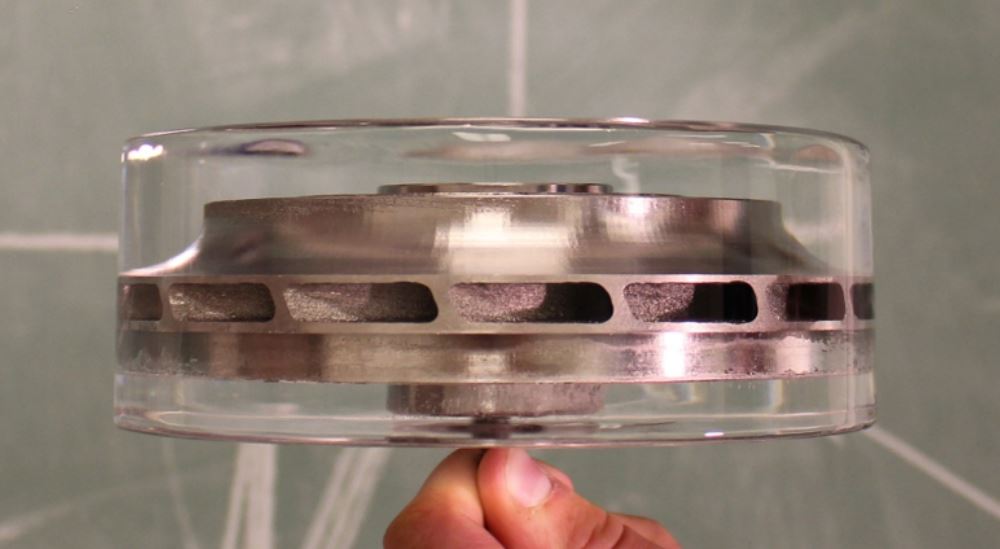Francesco Simonetti, an aerospace engineering professor at the University of Cincinnati, and his undergraduate student Michael Fox have developed a new method of non-destructive testing (NDT) for inspecting metal 3D printed components. Detailed in a study for NDT & E International the technique, termed cryoultrasonics, unusually combines ice and ultrasound to overcome inadequacies associated with other current methodologies.
Issues with non destructive testing
NDT, or non-destructive evaluation (NDE) as it is also known, is an effective method of inspecting the material properties of a part without damaging it. Common and effective NDT methods include X-ray computerized tomography (XCT) to decipher internal defects, and liquid penetrant inspection (LPI) for surface cracks. While these are well established non-destructive methods, they include several limitations. XTC, for example, has low sensitivity to crack-like defects or near-surface flaws, and LPI is impractical for the inspection of limited access areas such as internal vanes and channels. As such, they would have to be used together in order to take full effect.
Ultrasound is an alternative NDT method which is already used to find flaws in in traditionally machined metal parts. On its own however, ultrasound is impractical for uses with metal 3D printed parts. This is because ultrasound waves bounce off the curves and angles of a 3D printed part, masking any flaws within. The solution, as developed by Simonetti and Fox, is to immerse the part in a material that’s similar in density to the metal that it is made from (called a coupling medium). This means that the ultrasound waves can travel unimpeded through the medium and the 3D printed part, reflecting only off legitimate flaws.

Ice-olating the flaws with ultrasound
Several materials, including water, were tested as possible candidates by Simonetti and Fox but were all rejected due to their incompatible densities. Eventually they discovered that ice, similar in density to metal, did allow ultrasound waves to pass through it.
For ice to act as an effective coupling medium though, it has to be crystal clear. If any cracks or bubbles exist, ultrasound waves would reflect off of those rather than the defects in the part. As ice typically isn’t clear, especially when in bigger blocks, Simonetti and Fox needed to find a way to freeze ice around the part while keeping the ice transparent.
To overcome this issue they built a custom rig, combining things bought on Amazon, like baking pans, griddles and spindles. To prevent cracking of the ice, a cylinder with a metal base and plastic sides was used to submerge the part. The open top allows the ice to expand upwards out of the top of the cylinder as it is frozen from bottom to top, relieving pressure on the sides.
The bubbles, however, proved more challenging. “In order to prevent this phenomenon, you need to simply reduce the concentration of air on top of the freeze front,” explains Simonetti “To do that, we stir the water to have constant flow.”
Just the tip of the iceberg
Despite the impressive results of their research, the ice does have its limitations. Simonetti explains “Ideally, if the coupling medium were made of the same material as the part, it would be perfect. But that is not practical with something like liquid titanium. Experimentally, you couldn’t remove it.”
Simonetti and Fox are now experimenting with adding suspensions of nanoparticles to the water, aiming to create denser, heavier, stronger ice that’s a closer match to metal.
Details of the study, titled, “Experimental methods for ultrasonic testing of complex-shaped parts encased in ice” are published online in NDT & E International. It is co-authored by Francesco Simonetti and Michael Fox.
Vote for your 3D Printing Innovation of the Year in the annual 3D Printing Industry Awards.
Subscribe to the 3D Printing Industry newsletter for the latest news in additive manufacturing. You can also keep connected by following us on Twitter and liking us on Facebook. Looking for a career in additive manufacturing? Visit 3D Printing Jobsfor a selection of roles in the industry.
Featured image shows a round 3D-printed metal part, surrounded by ultra-clear ice within a plastic cylinder. Image via Corrie Stookey/CEAS Marketing



